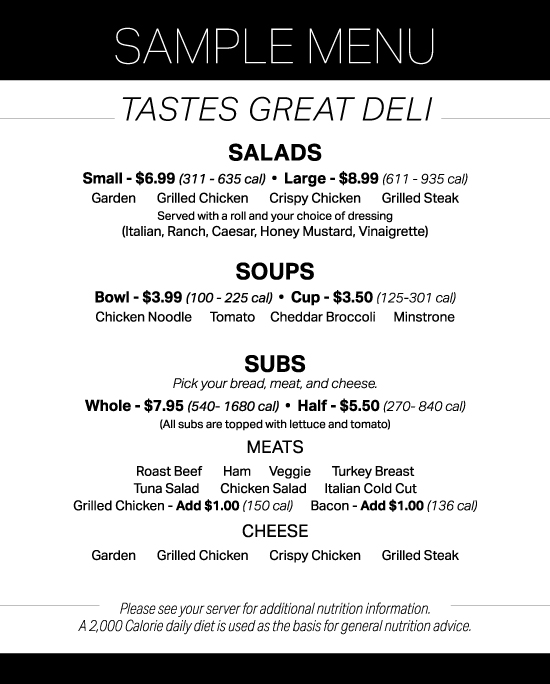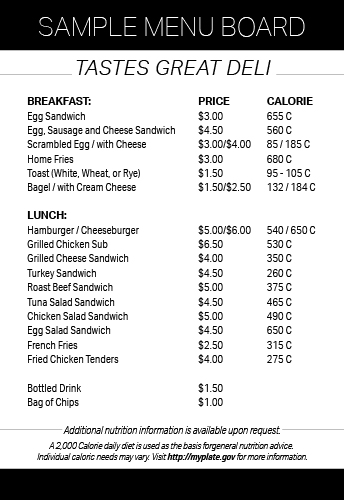Menu Labeling | Environmental Health

Calories for standardized menu items should be listed adjacent to that item on the menu.
Menu Labeling is required in Montgoemry County under
Regulation 15
, for eating and drinking establisments with
at least 20 locations in the United States.
According to Montgomery County Code, all establishments shall provide
"the
calories for each standardized menu item on the menu or menu board should be adjacent to the name of that item and additional nutritional information will be provided to a consumer upon request."
| Menu Labeling Documentation | Format |
|---|---|
| FDA Food Labeling Guidelines |
Helpful Menu Labeling Resources
Eating & Drinking Establishments - Nutrition Labeling
Amended Montgomery County Resolution 16-1194
Nutrition Information on Menu Boards and Menus
MyPlate Plan
Dietary Guidelines for Americans (DGA)
For assistance with services, email [email protected]


Menu & Menu Board Regulation 15 Labeling
- Calories: For each standard menu item in a manner that is clear and conspicuous to the customer.
- Rounding Calories: Refer to the Code of Federal Regulations (CFR) Titles 9 and 21 for additional information on rounding nutritional values.
- Abbreviation for "calorie": cal. or C
- Font Size: each font may be no less than 8pts in height.
- Typeface: Chosen typeface must be readable and ledgible.
- Daily Caloric Intake: A statement as to the current suggested daily caloric intake determined by the U.S. Department of Health and Human Services. An example of an approved statement is: "A 2,000 calorie diet is used as the basis for general nutrition advice. However, individual caloric needs may vary. Visit www.mypyramid.gov for more information."
- Additional Nutritional Information: A statement that additional nutrition information is available in writing upon consumer request.
- Alcohol: National values should be used for alcoholic beverages. Each size offering must have a calorie count or the minimum and maximum range posted.
What establishments must comply with RESOLUTION 15, and which are exempt?
Types of establishments that MUST COMPLY with
RESOLUTION 15
(Eating and Drinking Establishments - Nutrition Labeling) OF MONTGOMERY COUNTY
:
Any eating or drinking establishment located in Montgomery County that is part of a chain with at least 20 locations in the United States offering substantially the same menu items and doing business under the same trade name, regardless of individual ownership.
EXEMPT Establishments in MONTGOMERY COUNTY:
Grocery Stores, Convenience Stores and Movie Theaters.
Caloric Information for menu items
The number of calories for any standardized menu item must be posted next to that menu item and in a manner that is clear and conspicuous to the consumer.
Items that accompany a sandwich (such as chips, pickles or cheese):
If the item is listed separately on the menu or menu board and is not presented to the consumer in an original commercial package with the federally required nutrition information provided.
Menu item that is listed and served as a combination of different food items such as an appetizer sampler, sandwich meal or combination meal:
Post the minimum and maximum range of calories for all combinations of that menu item next to the item on the menu or menu board (for example, "choose two from the following list"). If the menu item is presented to the consumer as it is listed on the menu or menu board without a choice of flavors or variety, then the total number of calories must be posted next to the menu item (for example, "The appetizer sampler platter includes mozzarella sticks, buffalo wings and fried onions all for $10.00 (610 calories)").
How should I calculate the calorie and other nutrition content of a standardized menu item?
Calories must be posted for each standardized menu item as it is listed on a menu or menu board.
Menu items that may have a range of calories based on a consumer's choice of flavor or variety:
If the item is listed as a single menu item, post the minimum and maximum range of calories for each size offered (for example: "Build your own burrito. Choose from chicken, steak, pork or veggies. Add rice with red or black beans, all for $6.99 (310-600 cal.)"). The minimum and maximum values of the additional nutrition information must be available in writing upon request for each flavor or variety of that item. If the menu item lists the different flavors or varieties separately (for example, "add cheese for $1.00"), the number of calories must be listed separately next to the flavor or variety.
Requirements for buffets, salad bars, cafeteria lines, beverage stations or similar self-service operations:
The number of calories per serving or per item must be posted on a food tag adjacent to each food or drink offered for sale,
unless the information is provided on a menu or menu board. If the menu item is not listed on a menu or menu board, the two required statements must be posted at the cafeteria line, self-service unit or display case.
Standard, exempt menu Items & Alcoholic Beverages
What is a STANDARD Menu Item?
A standard menu item is a food or drink item as usually prepared and offered for sale. A standardized menu item does NOT include food or drink that:
- Appears on a menu for less than 60 cumulative days per calendar year.
- Is not listed on a menu or menu board (for example, condiments, spices or sweeteners placed on a table or counter for general use without charge)
- Is a test market item that appears on the menu for less than 90 cumulative days per calendar year, or is a daily special.
What is an EXEMPT Menu Item?
Condiments, garnishes and self-service commercially packaged items that already contain the complete nutritional labeling.
Does the law apply to Alcoholic Beverages?
Yes, if
listed on a menu or menu board. The following average nutritional values shall be used:
- Wine (5 ounces) - 122 calories, 4 grams carbohydrate, 7 milligrams sodium.
- Regular beer (12 ounces) - 153 calories, 13 grams carbohydrate, 14 milligrams sodium.
- Light beer (12 ounces) - 103 calories, 6 grams carbohydrate, 14 milligrams items that offer differing flavors or varieties. Each size offering must have a calorie count or the minimum and maximum range posted.
Menus & menu labeling explored
A "menu" or "menu board" is the primary writing of an eating and drinking establishment from which a consumer makes an order selection. This includes menus or menu boards posted at a drive-thru, on a children's placemat, for delivery or carryout, or as a table tent at a bar or on a dining table. Menus mailed or dropped off to a business or private residence must also comply with the law. Advertisements such as coupons and window posters are not included.
What info must be posted on each menu or menu board?
The
number of calories for any
standardized menu item posted next to that menu item and in a manner that is clear and conspicuous to the consumer.
A statement that additional nutrition information is available in writing upon request
Why is menu labeling necessary?
Why is the menu labeling law necessary?
- An increase in caloric intake is a key factor contributing to the increase in obesity in the United States. Obesity increases the risk for diseases such as diabetes, cardiovascular disease (heart disease and stroke), osteoarthritis, sleep disorders and cancer. Obese adults are also more likely to have high blood pressure and high cholesterol.
- Consumption of saturated fat results in a high level of low density lipoprotein (LDL). Elevated levels of LDL lead to the build-up of cholesterol in arteries which increases an individual's risk of heart disease.
- Excess dietary sodium may contribute to high blood pressure which, in turn, can lead to congestive heart failure, kidney failure and stroke.
- Data from 2003 showed that nearly 60 percent of all deaths in Maryland were caused by heart disease, cancer, stroke and diabetes. Heart disease alone accounted for 27 percent of all deaths. In addition, 25 percent of Maryland adults were diagnosed with high blood pressure and 34 percent were diagnosed with high cholesterol.
- The economic cost of obesity in the United States in 2000 was calculated at $117 billion. In 2007, the economic costs of heart disease and stroke were estimated at $432 billion.
- Food from eating and drinking establishments is generally higher in calories and saturated fat and lower in nutrients than home-prepared food.
What will happen if I do not comply with the menu/menu board labeling law?
- Any violation is a Class A civil violation which could result in the owner receiving a civil citation with a $500 fine for each offense. Each day a violation exists is a separate offense.
- The Director of Health and Human Services may suspend a license for up to three days if the Director finds that the operator of an eating and drinking establishment has knowingly and repeatedly violated the law.